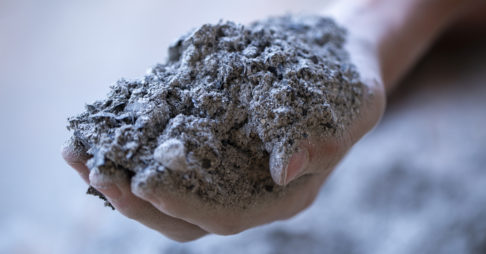Explanation of concrete raw materials – fly ash, mineral powder and their differences

Fly ash
The main quality indicators of fly ash are: fineness, loss on ignition, SO3 content, fCaO content, water demand ratio, water content. The fly ash that can be used for concrete and mortar is divided into grades I, II and III according to the above quality indicators. GB/T1596 “fly ash used in cement and concrete” has clear regulations on the above quality indicators of fly ash.
The main functions of fly ash in cement-based materials are: morphological effect, activity effect, and micro-aggregate effect. The morphological effect of fly ash is mainly manifested as filling and lubricating effects; the active effect of fly ash refers to the chemical effect produced by the active components of fly ash in concrete. If fly ash is used as a gelling component, this effect is naturally the most important basic effect, and the level of the active effect depends on the ability and speed of the reaction and the quantity, structure and nature of the reaction products. The micro-aggregate effect of fly ash means that the fine particles of fly ash are evenly distributed in the base phase of the cement slurry, just like fine aggregates. The addition of mineral powder to the cement paste can replace part of the cement clinker. The hardening process of concrete and the formation of its structure and properties depend not only on cement, but also on microaggregates.
(1) Fineness of fly ash
The fineness of fly ash has an important influence on the performance of concrete, which is mainly reflected in two aspects: one is to affect the activity of fly ash, the finer the fly ash, the stronger the pozzolanic reaction ability; Water-based, generally speaking, the thicker the undisturbed fly ash, the greater the water-based requirement. In concrete, water consumption is the most sensitive factor affecting its structure and performance. Mechanical grinding can improve the fineness of fly ash, but usually cannot reduce the water demand of fly ash.
(2) Loss on ignition of fly ash
The unburned carbon powder in the fly ash can be estimated by the loss on ignition. Carbon particles are harmful substances to concrete, which can increase the water consumption of concrete. The higher the carbon content in fly ash, the more water it needs. The color of fly ash can change from milky white to black with the change of carbon content. Undisturbed fly ash is usually lighter in color, and the mechanical grinding action breaks up these particles, exposing some unburned charcoal, so ground fly ash often takes on a darker color.
(3) fCaO content of fly ash
In low-calcium fly ash, most of CaO is bound in the vitreous body, and in high-calcium fly ash, in addition to most of it is bound, some of it is free. The free CaO in the “dead burn” state has the dual effects of promoting the activity and detrimental to the stability. Therefore, the stability of the high-calcium fly ash must be paid attention to.
(4) SO3 content of fly ash
Too high SO3 will produce destructive ettringite. Our country’s standard stipulates that the SO3 content in fly ash must be no more than 3%.
The high alkali content of fly ash will also lead to large drying shrinkage deformation of hardened cement stone, which is also detrimental to the crack resistance of concrete.
In addition, the use of high-quality fly ash, the larger the content, the more significant the water reduction effect. On the contrary, the use of inferior fly ash, the larger the amount of fly ash, the more water consumption of concrete increases.
The combination of fly ash and calcium hydroxide will reduce the alkalinity of concrete. These are side effects brought about by the chemical stabilization behavior of fly ash.
Finely ground ore powder
Main quality indicators of ground ore powder: activity index, ratio of fineness to specific surface area, and fluidity.
Fineness and specific surface area: Under the condition of constant mineral composition, the finer the fineness, the better its activity.
Activity of finely ground ore powder: The activity of finely ground ore powder has a certain relationship with its chemical composition. Generally speaking, the larger the alkalinity coefficient, the larger the activity coefficient, and the better the mineral powder activity.
The activity coefficient refers to the ratio of alumina content (%) to silica content (%) in the ground ore powder, namely: activity coefficient = Al2O3/SiO2
The basic coefficient refers to the ratio of basic oxide content (%) to acid oxide content (%) in the ground ore powder, namely: basic coefficient K=(CaO+MgO)/(SiO2+Al2O3)
The basic coefficient and activity coefficient only reflect the activity of the mineral powder from the chemical composition, but the activity of the mineral powder not only depends on the chemical composition, but also has a close relationship with the cooling speed and grinding fineness.
The fluidity ratio reflects the water demand of the mineral powder. The ground ore powder does not have the function of reducing water. When the specific surface area is large or the particle gradation is unreasonable, it may increase the water demand. With the improvement of the grade of ground ore powder, the requirement for the activity index also increases, but the requirement for the fluidity ratio decreases. When higher grades of finely ground mineral powder are used, the water consumption of the concrete may be increased.
Comparison of ground ore powder and fly ash
The water retention performance of ground ore powder is far less than that of high-quality fly ash, and some ground ore powder with poor gradation often causes serious bleeding, which is a negative effect of fine ore powder.
The finely ground mineral powder is characterized by a very high active behavior and gelling properties. The disadvantage of finely ground mineral powder is poor volume stability. High-quality fly ash is characterized by water reduction and better volume stabilization. The disadvantage of fly ash is its poor activity.
